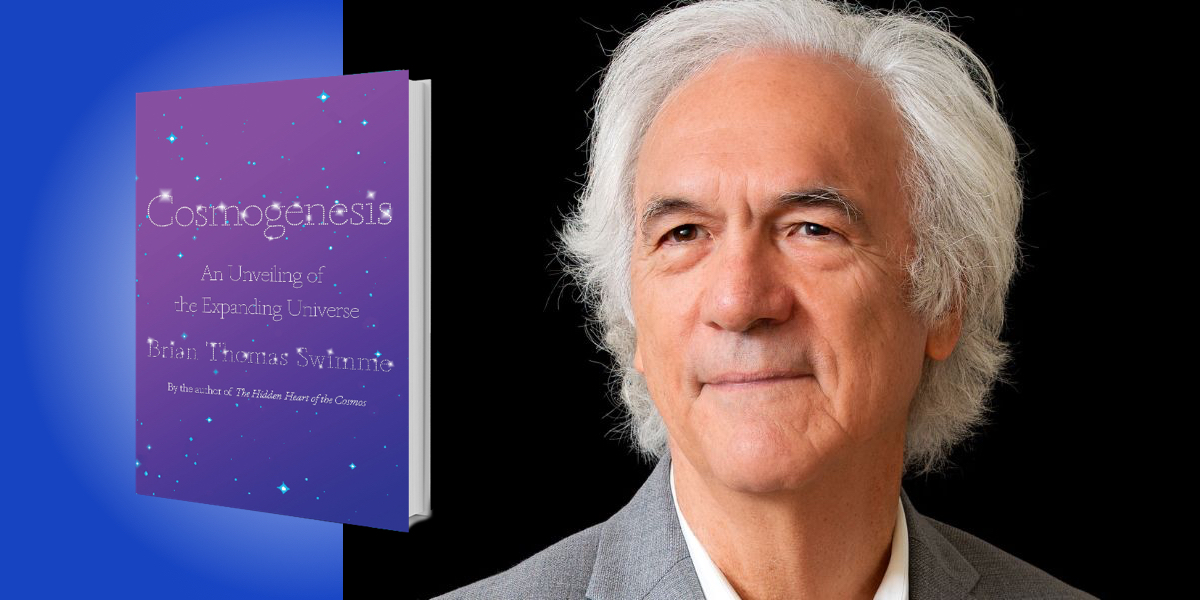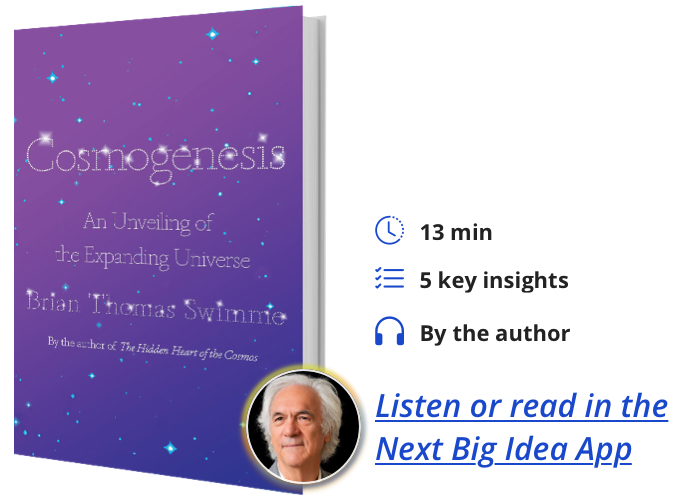Brian Thomas Swimme is a professor of evolutionary cosmology at the California Institute of Integral Studies. He is the co-creator and host of the Emmy award-winning PBS documentary Journey of the Universe, and the co-founder of the Center for the Story of the Universe, which produces content that strives to bring together humanity as a vibrant global community.
Below, Brian shares 5 key insights from his new book, Cosmogenesis: An Unveiling of the Expanding Universe. Listen to the audio version—read by Brian himself—in the Next Big Idea App.
1. We are cosmological beings.
The most radical discovery of four hundred years of modern science is our realization that the universe constructed us. Each carbon atom of our body was built in the core of some star. The fusion reaction in the core of a star is the only process in the universe that can make carbon or oxygen or any of the other elements that compose us.
The universe not only constructs the matter of our body, but it also provides the energy of our lives. Here’s the sequence: If we twiddle our fingers, the ergs (units of work) of energy enabling this action come from the food we’ve eaten. The food received its energy from the Sun. The Sun received its energy from the gravitational collapse of the galactic cloud that gave birth to it. That cloud received its gravitational potential energy from the flaring forth of the universe fourteen billion years ago. Each time we move a finger, we are drawing upon the energy that burst forth at the beginning of time.
At a secondary level, we are American or Chinese, mothers or fathers. But at the most fundamental level, each of us is an elegant construction of the universe. This is what we have in common. We are all cosmological beings.
2. Relationship determines everything.
When two entities enter into a relationship, they are changed in their fundamental nature—they’re different, and they’re new.
An example from physics makes this clear. The neutron (an elementary particle), left alone, decays after a few minutes. But if that same neutron enters into a relationship with a proton, it can exist for billions of years. A neutron in relationship with a proton is fundamentally different from a neutron all by itself.
“Nothing came to Earth from the outside.”
Consider an example from the whole cosmos. In the beginning of time, the universe was a plasma composed of elementary particles. Over a billion years, these particles entered into relationships with each other and brought forth trillions of stars and galaxies. By exploring relationships, the primordial soup at the origin of time transformed into the gigantic structures of the large-scale universe.
An especially dramatic demonstration of relationship’s power comes from the history of life. For several eons, life on our planet consisted solely of single-celled organisms, each one smaller than the sharp end of a pin. After three billion years, they entered into relationships with one another, relationships which brought forth whales, dinosaurs, and oak trees. What needs to be appreciated is that nothing more than these single-celled organisms were involved. Nothing came to Earth from the outside. Relationships transformed tiny cells into large animal bodies with intricate animal minds. The power of relationship accomplished all of that.
3. The universe is intelligent.
Before the discovery of cosmological creativity, it was possible to think of the universe as composed of inert matter. But now that we know this matter has constructed living cells and animals with brains, does it make sense to think of matter as inert?
The matter of the universe has a form of intelligence that knows how to do astonishing things. Stars know how to create carbon and phosphorous. Ancient bacteria knew how to create photosynthesis. The universe as a whole has the same kind of intelligence, as can be seen in its expansion. Edwin Hubble discovered in the early 20th century that all the galaxies were expanding away from each other. When the mathematical cosmologist Stephen Hawking examined this, he proved that the expansion was just what it had to be in order for living planets to emerge. If the expansion rate were altered by even a trillionth of a trillionth of a trillionth of one percent, the universe never would have produced life. That is to say, the universe is expanding at the rate it is expanding because the universe “knows” how to bring forth life.
“If the expansion rate were altered by even a trillionth of a trillionth of a trillionth of one percent, the universe never would have produced life.”
The physicist Freeman Dyson, at Princeton’s Institute for Advanced Study, summarized these discoveries with a single phrase: The more I examine the universe and study the details of its architecture, the more evidence I find that the universe in some sense must have known we were coming.
4. Humanity constructed its mind.
We can see this most clearly when we compare ourselves to our closest kin, the chimpanzee. We are 99 percent identical genetically. Five million years ago, humans and chimpanzees were indistinguishable. Our minds were chimpanzee minds. After five million years of evolution, humans and chimpanzees are still 99 percent identical, genetically, but humans have consciously participated in the development of new mentalities. These new mental powers have enabled humans to spread over Earth’s surface, learn the processes of their own biology, articulate the mathematical laws of the cosmos, explore the bottom of the oceans, construct ten thousand cities, fly to the Moon, assemble libraries, and transform the entire biosphere. While all this was going on, the chimps stayed in equatorial Africa, using the same mind we once shared.
Scientists have identified nine developments of human mentality that were carried out by humanity itself.
Consider one of these, the development of reproductive imagination. Reproductive imagination is the ability to consciously recall an experience from the past. We take this for granted now, but it is a mentality that had to be evoked inside caves.
For hundreds of thousands of years, humans journeyed into caves that offered no biological advantages. They held neither food nor mating partners. Our ancestors went there for a strange experience. Imagine yourself inside one of these caves, you have a chimpanzee mind, and you sit in the dark, half a mile beneath the surface of the Earth. Torches are flickering as you watch one of your friends do something weird. With a burnt stick, he’s making marks on the wall, squiggly lines, or tiny dots.
“There is no physical horse, but there is an imagined horse.”
After a time, something amazing takes place. A horse suddenly appears, right there on the rock. There is no physical horse, but there is an imagined horse. As you glance around, you see others having this strange experience of reproducing something from a former moment. In this way, humanity added the reproductive imagination to its mental skill set. One by one, new powers of mind have been brought forth. This developmental process of evoking new powers of mind continues today.
5. The new mentality being evoked in our time is the ability to experience the universe folding back on itself.
One of the most significant events in the history of humanity is the detection of light from the beginning of time. The discovery of this light, called the cosmic microwave background radiation, was accomplished in 1964 by two scientists working at Bell Labs in New Jersey. They were the first to realize that light from the origin was arriving here after a fourteen-billion-year flight. With contemporary telescopes, we can interact physically with this light. It is here now. In the space of your cupped hands, there are seven thousand photons flashing after traveling here from the origin of the universe. We are learning to experience ourselves as the constructions of the outburst of light and matter that have evolved over billions of years and now reflect in us. We are the primordial flaring forth reflecting back on fourteen billion years of cosmological creativity.
The realization that in human consciousness the universe folds back upon itself is the first step into this new mentality. We can experience it directly in many ways. When we look at the stars, we need only reflect on the fact that stars constructed the atoms of our bodies. When we look at the stars we are beholding that which constructed the eyes that are doing the beholding. Our minds are challenged by this figure-ground transformation: the inner is looking at the outer which has given birth to the inner. There is the heart of cosmogenesis, looking out at processes that gave birth both to the carbon of our eyes and the thinking of our minds. These phrases simply state what mathematical and observational cosmologists have discovered: when we look out at the night sky, we are looking out at that which is looking.
To listen to the audio version read by author Brian Thomas Swimme, download the Next Big Idea App today:
































